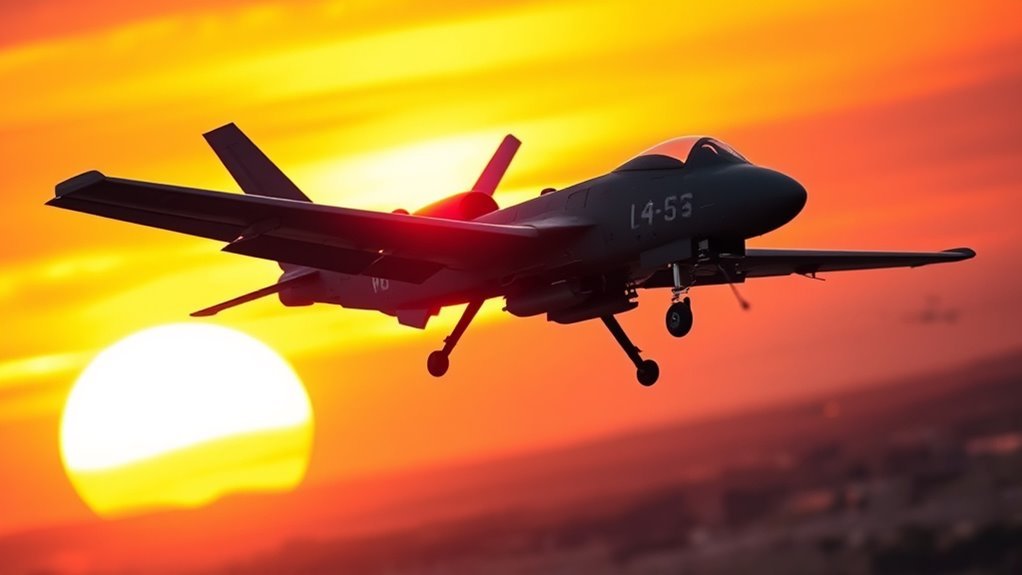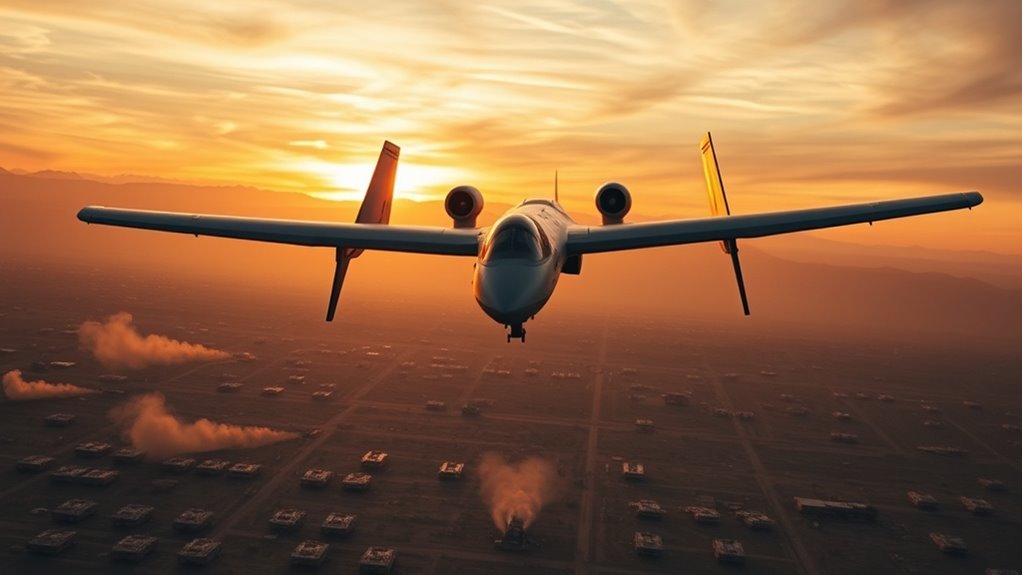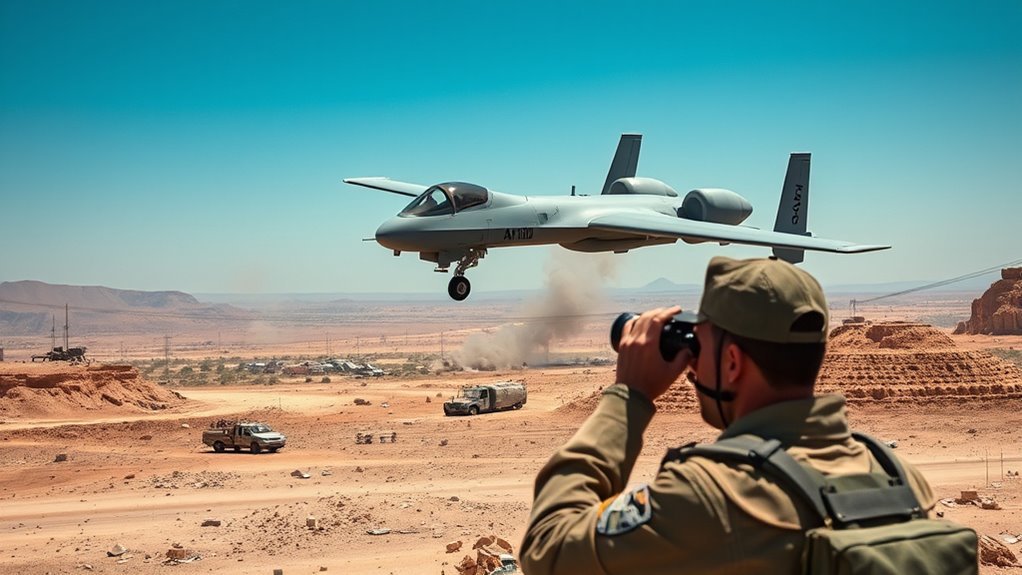The A-10 drone is a game changer in warfare due to its advanced stealth technology, real-time intelligence, and enhanced AI for precision targeting. Its ability to integrate seamlessly with ground forces improves operational efficiency, while extended loiter time allows for sustained situational awareness. Additionally, its impact on enemy morale through psychological warfare further disrupts adversary planning. Understanding these facets reveals how the A-10’s innovations are reshaping modern combat and redefining tactical superiority.
The Evolution of Aerial Warfare

Since the dawn of aviation, aerial warfare has undergone significant transformations, adapting to technological advancements and shifting tactical paradigms. One of the most pivotal developments in this arena is drone technology. Drones have redefined the concept of air superiority, allowing for remote engagement and surveillance without risking pilots’ lives. These unmanned systems enhance situational awareness, enabling you to gather intelligence and strike targets with precision. The evolution from traditional manned aircraft to drones signifies a strategic shift, emphasizing flexibility and efficiency. As drone technology progresses, it’s imperative to understand its implications for warfare dynamics, particularly in achieving and maintaining air superiority. Embracing these innovations can empower you to navigate the complexities of modern combat effectively, especially considering the limitations of drones seeing through walls. Furthermore, advancements in real-time collision avoidance and swarm behavior optimization further enhance the operational capabilities of drones in combat scenarios.
Key Features of the A-10 Drone

While the A-10 drone isn’t a conventional unmanned aerial vehicle, it incorporates key features that enhance its effectiveness in modern warfare. Its advanced stealth technology minimizes detection, allowing you to conduct operations with a tactical advantage. This drone’s design reduces its radar cross-section, making it less visible to enemy systems. Additionally, drone autonomy plays an essential role in its operational capability; it can execute complex missions with minimal human intervention, increasing efficiency and response times. This autonomy allows for real-time data processing, enabling quicker decision-making in dynamic combat environments. Together, these features not only optimize mission success but also empower you with greater strategic flexibility, redefining how aerial warfare is approached in pursuit of freedom and security.
Close Air Support: A New Paradigm

The A-10 drone’s advanced capabilities considerably reshape the concept of Close Air Support (CAS) in modern combat operations. By leveraging unmanned systems, you can achieve unprecedented battlefield coordination, allowing for real-time decision-making and enhanced tactical flexibility. This shift empowers ground forces, providing them with immediate aerial support while minimizing risks to human pilots. Furthermore, the integration of AI-driven algorithms enhances situational awareness, further improving operational efficiency in complex combat environments. Additionally, the predictive algorithms employed in these systems allow for more accurate threat assessments and timely interventions.
| Feature | A-10 Drone | Traditional CAS |
|---|---|---|
| Pilot Risk | No human pilot | High-risk for pilots |
| Response Time | Near-instantaneous | Slower due to logistics |
| Coordination | Enhanced via UAS tech | Limited communication |
| Target Precision | High | Variable |
| Cost Efficiency | Lower operational costs | Higher operational costs |
This transformation is pivotal in ensuring freedom and effectiveness on contemporary battlefields.
Advanced Targeting and Surveillance Capabilities
As advanced targeting and surveillance capabilities become integral to modern warfare, the A-10 drone stands out for its ability to provide real-time intelligence and precision strike options. Its sophisticated targeting algorithms enhance accuracy, allowing you to identify and engage threats with minimal collateral damage. The drone’s advanced surveillance technology enables continuous monitoring of dynamic battlefield environments, ensuring you stay one step ahead of enemy movements. With high-resolution imaging and robust data processing, it delivers actionable insights that empower strategic decision-making. By integrating these capabilities, the A-10 not only maximizes operational efficiency but also reinforces your commitment to safeguarding freedom. Ultimately, its advanced targeting and surveillance features redefine how you approach modern combat scenarios, making it an invaluable asset in your arsenal.
Extended Loiter Time and Its Strategic Importance
Extended loiter time greatly enhances the strategic value of the A-10 drone, allowing it to maintain a persistent presence over the battlefield. This capability enables you to conduct extended missions without the immediate pressure of returning to base for refueling or rearming. As a result, you gain significant strategic advantages, including the ability to monitor enemy movements, assess battlefield conditions, and provide real-time intelligence to ground forces. The drone’s extended capabilities also allow for timely support during vital moments, ensuring that your forces can respond effectively to dynamic threats. By maximizing operational endurance, the A-10 drone not only extends your reach but also elevates your tactical flexibility, providing a key edge in modern warfare.
Precision Strikes: Minimizing Collateral Damage
With its extended loiter time, the A-10 drone not only enhances battlefield surveillance but also excels in executing precision strikes. This capability allows for targeted engagement, ensuring that each strike hits its intended target while minimizing collateral damage. You’ll appreciate how it employs advanced targeting systems, which facilitate:
- Laser-guided munitions that pinpoint enemy positions
- Real-time data feeds for improved situational awareness
- Enhanced sensor technology for identifying threats
- Strategic planning to avoid civilian areas
Such features are essential for collateral mitigation, promoting operational effectiveness while aligning with ethical warfare principles. By reducing unintended harm, the A-10 drone proves to be a crucial asset in modern combat, ensuring freedom can be preserved with minimal disruption to civilian life.
Versatility Across Different Combat Environments
Although the A-10 drone is primarily associated with close air support, its design and capabilities allow it to adapt seamlessly to various combat environments. This versatility is essential, especially in urban warfare, where precision and situational awareness are paramount. The drone’s ability to conduct aerial reconnaissance provides real-time intelligence, enabling commanders to make informed decisions on the battlefield.
| Combat Environment | Key Features | Strategic Advantage |
|---|---|---|
| Urban Warfare | High maneuverability | Minimizes civilian casualties |
| Mountainous Regions | Advanced sensors | Enhanced surveillance |
| Desert Operations | Long endurance | Sustained mission capability |
| Maritime Areas | Target tracking abilities | Effective against naval threats |
In each scenario, the A-10 drone proves to be an indispensable asset.
Integration With Ground Forces
As the battlefield evolves, the integration of the A-10 drone with ground forces becomes increasingly essential for operational success. This synergy enables effective joint operations, enhancing troop coordination in dynamic environments. By leveraging real-time data and aerial support, ground forces can execute missions with unparalleled precision.
- A-10 drones providing close air support during an infantry advance
- Enhanced situational awareness through live video feeds
- Coordinated strikes on enemy positions, reducing collateral damage
- Immediate response to threats, bolstering troop morale
The A-10’s capabilities allow for seamless communication between air and ground units, ensuring that every soldier has the backup they need. This integration not only improves mission outcomes but also reinforces the collective commitment to freedom and security.
The Psychological Impact on Enemy Forces
The psychological impact of the A-10 drone on enemy forces can be profound, especially when they realize that their movements are constantly monitored from above. This state of constant surveillance serves as a tool of psychological warfare, eroding enemy morale and instilling a sense of vulnerability. As they recognize their inability to operate freely without detection, fear and uncertainty begin to permeate their ranks. The A-10’s advanced capabilities amplify this effect, creating a perception of omnipresence that can lead to hesitation in decision-making. When enemy forces doubt their ability to execute plans without being targeted, their resolve weakens. In this manner, the A-10 drone doesn’t just alter the battlefield; it shapes the mental landscape, forcing adversaries to confront their own limitations.
Future Developments and Potential Enhancements
While advancements in drone technology continue to evolve rapidly, the future of the A-10 drone in warfare promises to incorporate enhancements that greatly increase its operational effectiveness. As you consider the potential of future upgrades, keep in mind the strategic edge these technological innovations could provide:
The A-10 drone’s future enhancements promise to redefine aerial combat with transformative technological advancements.
- Enhanced AI for real-time target recognition and tracking
- Advanced stealth capabilities to reduce radar visibility
- Increased payload capacity for diverse weapon systems
- Autonomous operational capabilities for prolonged missions
These upgrades aren’t just improvements; they’re transformative shifts that could redefine aerial combat. By integrating cutting-edge technology, the A-10 drone could become an even more formidable asset on the battlefield, ensuring that you maintain freedom and tactical superiority in increasingly complex warfare scenarios. Additionally, advancements in predictive maintenance capabilities could further enhance the reliability of the A-10, minimizing downtime and maximizing mission readiness.
Frequently Asked Questions
How Does the A-10 Drone Compare to Manned Aircraft in Combat?
When you compare the A-10 drone to manned aircraft, its advanced drone capabilities enhance combat efficiency, allowing for precise strikes and reduced risk to pilots, making it a strategic asset in modern warfare scenarios.
What Is the Cost of Operating an A-10 Drone?
When considering the A-10 drone, you’ll find operational expenses are often lower than manned aircraft. However, maintenance costs can still accumulate, impacting overall budget efficiency while aiming for strategic advantages in aerial warfare.
Are There Any Notable Historical A-10 Drone Missions?
You’ll find A-10 missions have historical significance, especially during Operation Desert Storm, where their close air support capabilities effectively targeted armored units. Analyzing these missions reveals strategic advantages that shaped modern aerial warfare tactics and outcomes.
How Does Pilot Training Differ for Drones Versus Traditional Aircraft?
Pilot training for drones emphasizes drone simulation, enhancing pilot adaptability in diverse scenarios. Unlike traditional aircraft, it focuses on virtual environments, allowing you to refine decision-making skills without the constraints of physical flight, ensuring effective strategic operations.
What Are the Ethical Concerns Surrounding Drone Warfare?
In the shadow of warfare’s evolving landscape, you’ll find ethical concerns about autonomous decision making. The risk of civilian casualties looms large, challenging the morality of remote strikes and highlighting the need for accountability and restraint.

